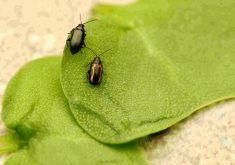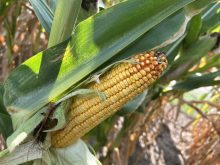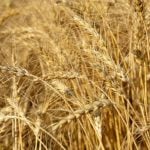After a couple of dry years and significant losses due to flea beetle infestations, canola farmers are asking if the wet soils they’re planting into might be cause for optimism. The answer, it appears, is a resounding, “maybe.”
Stress to canola is stress to canola, whether it comes from a wet spring or a year of drought, and either way, it gives an edge to the flea beetles.
“Any time that the canola is growing slowly and the flea beetles are eating quickly, it’s bad for canola production,” said Keith Gabert, an agronomy specialist with the Canola Council of Canada.
Certainly, drought conditions last year met that criteria and, as a result, crop damage was significant. Flea beetles thrived in the warm, dry conditions, while canola markedly did not, exacerbating the damage. This year, the term “dry” certainly does not apply. But while this year has, so far, been a mirror opposite to 2021, there is still plenty of opportunity for other stress — poor seeding conditions, poor establishment, or even a late frost.
If this year’s canola crop doesn’t establish faster than the flea beetles feed, it could be just as bad as last year.
“It’s rarely just (about) having too many flea beetles,” Gabert said. “Often, you have too many flea beetles and you have a drought, or you have some crusting, so you only get two or three plants per square foot and you have flea beetles happily munching those away as you watch.”
But while he’s not exactly all optimism, Gabert remains hopeful.
“Typically, delayed seeding into what’s usually warmer soil means that we tip the balance a little bit away from flea beetles and towards the canola crop,” he said.
While planting in warmer soil helps, the crop also needs to grow rapidly in order to outrun the window of their seed treatment, an issue that, in other years, has plagued some farmers with early-seeded canola that then failed to thrive.
Common knowledge puts seed treatment window at three (perhaps four, if feeding conditions for the beetle are poor) weeks.
Beyond seed treatment, farmers have to get out in the field and scout, Gabert said. If that refrain sounds familiar, there’s a good reason for it.
“It’s exactly the same advice every year,” he said.
“Often (farmers) are in the middle of seeding something else still, or they just managed to finish seeding and they’re madly getting the sprayer running,” he added. “They’re trying to do too many things in too little time and sometimes just going out and taking a look to see if those insects are feeding is something that they skipped.”
Gabert reminded farmers that flea beetles come with an economic threshold of 25 per cent leaf defoliation with continued feeding, at which point they may want to consider jumping in the sprayer cab.
For this year to show any significant improvement over recent years in terms of flea beetles, farmers will need a little luck.
“We’d love to see a rapidly growing crop that gets to three or four leaves in three to four weeks,” Gabert said.

Plants at four leaves are generally considered to have enough plant material that feeding won’t make an economic impact.
“It’s a bit of a race between the crop growing and insects managing to find enough food,” Gabert said.
At this point, it’s too soon to call a winner in that race.
Gabert has an anecdotal quip ready for anyone asking him to make a prediction about flea beetles: “I tell people 20 per cent of the Prairies will have a concern with flea beetles. I just can’t tell them what 20 per cent it is.”
But he says that 20 per cent is almost always tied to challenging establishment conditions. The flea beetle is the constant.
“We have 20 million acres or so of canola. So anywhere you go in the Prairies, there’s a good food source for flea beetles. They’re well established. The advantage they have is that they wake up hungry and they’re ready to eat. They’re not strong fliers. They don’t migrate far, but there’s enough canola in Western Canada that they don’t have to migrate far to find the next field,” he said.
The canola council is not advising any major shift in flea beetle control strategy.
















